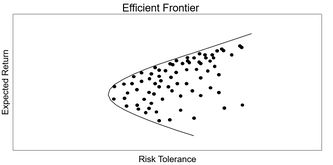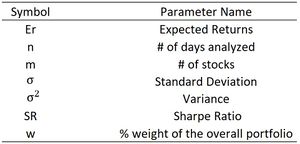Portfolio optimization: Difference between revisions
Kevinpan156 (talk | contribs) (→Theory) |
Kevinpan156 (talk | contribs) (→Theory) |
||
| Line 8: | Line 8: | ||
The x- axis represents the standard deviation of the data, which is also known as the risk tolerance. On the y- axis is the expected percent return. The points near the solid line are optimal, which is also known as the frontier line. Any points that fall below the curve are considered to be nonoptimal. This is due to the fact that with the same risk tolerance there are better expected returns. This method has its limitations as it relies on past data. | The x- axis represents the standard deviation of the data, which is also known as the risk tolerance. On the y- axis is the expected percent return. The points near the solid line are optimal, which is also known as the frontier line. Any points that fall below the curve are considered to be nonoptimal. This is due to the fact that with the same risk tolerance there are better expected returns. This method has its limitations as it relies on past data. | ||
[[File:Figure 1- Efficient Frontier Graph.jpg|thumb|333x333px|Figure 1: Efficient Frontier Graph]] | [[File:Figure 1- Efficient Frontier Graph.jpg|thumb|333x333px|Figure 1: Efficient Frontier Graph]] | ||
Revision as of 22:31, 28 November 2021
Authors: Ainsely Li (fl366), Kevin Pan (kp428), Qizeng Sun (qs95), Hanshen Li (hl2436), Eric Luo (yl2429) Fall 2021
Introduction
Portfolio optimization is a way to minimize risks to maximize net gains in a portfolio. Apply probability statistics, linear algebra, optimization and other methods to redistribute the investment portfolio under the established target returns and risk limits to achieve the goal of reducing risks or obtaining higher benefits under the same risk conditions.
Risk is a major factor in choosing stocks in a portfolio. In order to mitigate these risks, investors typically use an efficient frontier graph as shown in figure 1.
The x- axis represents the standard deviation of the data, which is also known as the risk tolerance. On the y- axis is the expected percent return. The points near the solid line are optimal, which is also known as the frontier line. Any points that fall below the curve are considered to be nonoptimal. This is due to the fact that with the same risk tolerance there are better expected returns. This method has its limitations as it relies on past data.

Theory
The portfolio optimization mainly assumes two directions. The first is to assume that an investor has a fixed amount of investment in his hand, and requires to find one that has the smallest investment risk under certain relevant constraints of known investment projects. The other direction is to find a portfolio with the greatest return on investment under the same assumptions.

The mitigation of risk can be characterized as follows. Let A be a matrix mxn of the daily returns, where m is the number of stocks and n is the number of days that are being analyzed.
Er represents the expected returns of the stock which is the average of the individual column of M. σ is the standard deviation of the individual the data set of an individual stock, where σ is the variance.
X = A - Er
X represents the daily return subtracted by the expected returns of each respective stock. The variance and covariance table is a vital tool as it allows the user to estimate volatility of the overall portfolio.
Σ= XX(n-1)
